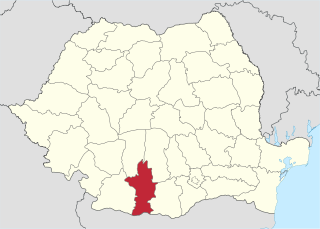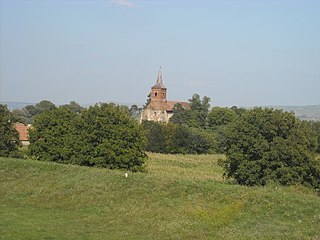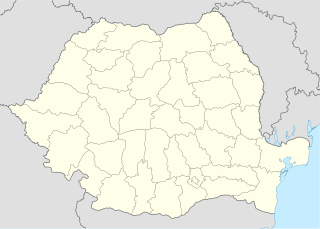
Olt County is a county (județ) of Romania on the border with Bulgaria, in the historical regions of Oltenia and Muntenia. The capital city is Slatina.

The Olt is a river in Romania. It is 615 km (382 mi) long, and its basin area is 24,050 km2 (9,290 sq mi). It is the longest river flowing exclusively through Romania. Its source is in the Hășmaș Mountains of the eastern Carpathian Mountains, near Bălan, rising close to the headwaters of the river Mureș. It flows through the Romanian counties Harghita, Covasna, Brașov, Sibiu, Vâlcea and Olt. The river was known as Alutus or Aluta in Roman antiquity. Olt County and the historical province of Oltenia are named after the river.

Ceamurlia de Jos is a commune in the southeast of Tulcea County, Northern Dobruja, Romania. It has a total population of 2,620 and it has an area of 119,43 km². The Golovița Lake is located south of this commune. Its name is derived from Turkish Çamurlu, meaning "muddy".

Vințu de Jos, also known as Vinț, is a commune located in the centre of Alba County, Transylvania, Romania. It is composed of eighteen villages: Câmpu Goblii, Ciocașu, Crișeni (Krieschen), Dealu Ferului, Gura Cuțului (Gurrenkutz), Hațegana (Hetzingen), Inuri, Laz (Slawendorf), Mătăcina (Mattatschin), Mereteu, Pârău lui Mihai (Michelsdorf), Poienița (Pojenitz), Stăuini (Stabing), Valea Goblii, Valea lui Mihai (Michaelsdorf), Valea Vințului, Vințu de Jos and Vurpăr.

Tomșani is a commune located in Vâlcea County, Oltenia, Romania, about 43 km from Râmnicu Vâlcea and 5 km from Horezu. It is composed of eight villages: Bălțățeni, Bogdănești, Chiceni, Dumbrăvești, Foleștii de Jos, Foleștii de Sus, Mirești and Tomșani.

Beștepe is a commune in Tulcea County, Northern Dobruja, Romania. Its name comes from Turkish, meaning "five hills/peaks", due to a chain of hills which lie nearby.
Bobu or BOBU may refer to:

Valcău de Jos is a commune in Sălaj County, Crișana, Romania. It is composed of six villages: Lazuri (Újvágás), Preoteasa (Füzespaptelek), Ratovei (Rátonbükk), Sub Cetate (Valkóváralja), Valcău de Jos and Valcău de Sus (Felsővalkó). It is 14 km southwest of Șimleu Silvaniei.

Vișeu de Jos is a commune in Maramureș County, Maramureș, Romania. It is composed of a single village, Vișeu de Jos. The river Vișeu, a tributary of Tisa, flows through this commune.

Comǎna is a commune in Brașov County, Transylvania, Romania. It is composed of four villages: Comăna de Jos, Comăna de Sus (Felsőkomána), Crihalma and Ticușu Nou.
The Pârâul Roșu is a right tributary of the river Olteț in Romania. It flows into the Olteț in Osica de Jos. Its length is 12 km (7.5 mi) and its basin size is 31 km2 (12 sq mi).

Horodnic de Jos is a commune in Suceava County, Romania. It is composed of a single village, Horodnic de Jos. From 1950 to 2003, under the name of Horodnic Commune, it included Horodnic de Sus village; that was then split off to form a separate commune, and Horodnic was renamed Horodnic de Jos.

Pianu is a commune located in Alba County, Transylvania, Romania. It has a population of 3,390 and is composed of five villages: Pianu de Jos (Alsópián), Pianu de Sus, Plaiuri (Plaintelep), Purcăreți (Sebespurkerec) and Strungari (Sztrugár).

Viștea is a commune in Brașov County, Transylvania, Romania. It is composed of five villages: Olteț (Besimbák), Rucăr, Viștea de Jos, Viștea de Sus (Felsővist) and Viștișoara (Kisvist). It also included Drăguș village until 2004, when it was split off to form a separate commune.

Chiheru de Jos is a commune in Mureș County, Transylvania, Romania. It is composed of four villages: Chiheru de Jos, Chiheru de Sus (Felsőköhér), Urisiu de Jos (Alsóoroszi), and Urisiu de Sus (Felsőoroszi).

Dobrun is a commune in Olt County, Oltenia, Romania. It is composed of five villages: Chilii, Dobrun, Roșienii Mari, Roșienii Mici, and Ulmet. It also included Bobu and Osica de Jos villages until 2004, when these split off to form Osica de Jos commune.

Oarța de Jos is a commune in Maramureș County, Crișana, Romania. It is composed of three villages: Oarța de Jos, Oarța de Sus (Felsővárca), and Orțița (Középvárca).

Lunca Cernii de Jos is a commune in Hunedoara County, Transylvania, Romania. It is composed of eight villages: Ciumița (Csumicapuszta), Fântâna (Vádtelep), Gura Bordului, Lunca Cernii de Jos, Lunca Cernii de Sus (Felsőnyiresfalva), Meria (Kékesfalva), Negoiu (Nyegojlunka) and Valea Babii.

Alba County is a county (județ) of Romania located in the historic region of Transylvania. Its capital is Alba Iulia, a city with a population of 63,536.
Osica may refer to several places in Romania:



















